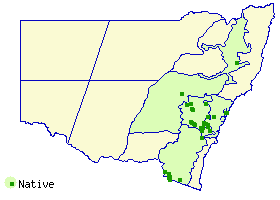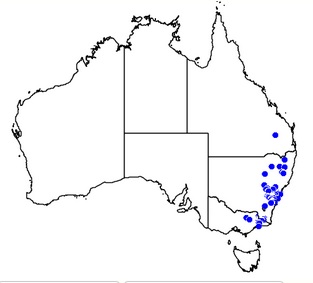Acacia amoena
| Acacia amoena |
|
|---|---|
Contents
General Plant Info
Called Acacia amoena (which means "pleasant or lovely"), this 2m erect shrub is widely known as "Boomerang Wattle". The distinctive feature of the Boomerang Wattle is the number of glands that occur along the margin of the phyllodes. Most wattles have only one gland, but on acacia amoena there are usually two nectar-secreting glands on the phyllode margins, but in some cases there may be three or four.
Plants with longer phyllodes may resemble Acacia hakeoides and it can also resemble Acacia chalkeri with which it may occur, however, both of these species have heads with more flowers.
Geographic distribution
Distribution and occurrence: Grows in dry sclerophyll forest and woodland chiefly on the ranges, often in rocky sties west to Wellington district.
Acacia amoena is found in the Apsley Falls area and beside the Oxley Highway, east of Walcha at Stony Creek.
Also occurs in Queensland and Victoria.
Identification
Description: Erect or spreading shrub 0.5–3 m high; branchlets angled at extremities, soon terete and ridged, reddish brown, glabrous.
Phyllodes usually ± oblanceolate to elliptic, straight or sometimes slightly curved, mostly 3–7.5 cm long (range: 2–8.5 cm long) and 5–12 mm wide (sometimes up to 16 mm wide), leathery, glabrous, with a prominent midvein, indistinctly penniveined, apex acute or subacute with a mucro; 2–4 prominent glands along margin; pulvinus 1–2.5 mm long.
Inflorescences mostly 5–21 in an axillary raceme; axis 1–6 cm long (often with some racemes < 1 cm with 2–4 heads); peduncles 1–6 mm long, glabrous; heads globose, 6–12-flowered, 3–5 mm diam., yellow to bright yellow or sometimes pale yellow.
Pods straight or variably curved, ± flat, slightly and sometimes irregularly more deeply constricted between seeds, 4–12 cm long, 4–6.5 mm wide, firmly papery to thinly leathery, ± smooth, glabrous; seeds longitudinal; funicle encircling seed in a single or sometimes double fold, arilate.
Flowering: July–October, December.
The phyllodes are 3-7 centimetres long and about one centimetre wide.
The globular flower heads contain 6-12 individual, bright yellow flowers. During spring the flowers are both profuse and very conspicuous.
Alkaloid content
Other uses
Extraction
Cultivation
Suppliers
Links
- http://aps-armidale.org.au/resources/facts/profiles/acacia.html
- http://plantnet.rbgsyd.nsw.gov.au/cgi-bin/NSWfl.pl?page=nswfl&lvl=sp&name=Acacia~amoena


